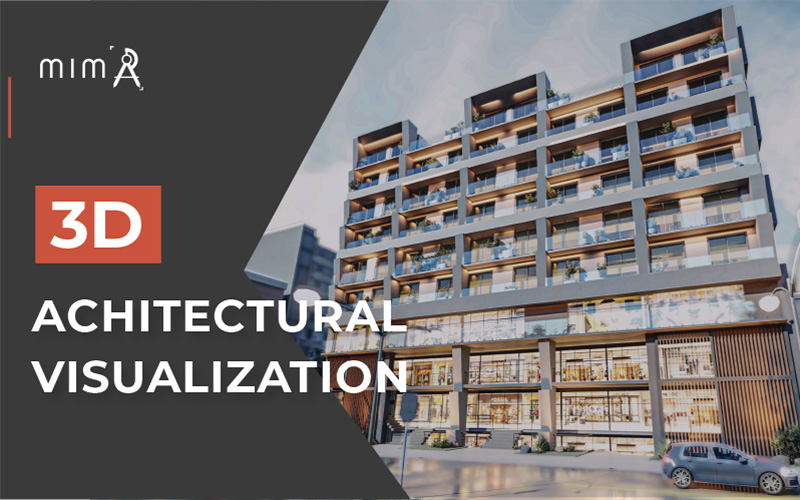Home » 3D Architectural Visualization » 3D Architectural Visualization – Top FAQs 2022
3D architectural visualization allows architects to provide their clients with a highly realistic representation of their projects. Property developers and other real estate companies can benefit greatly from 3D photorealistic renderings. They are simply revolutionizing the real estate industry across the globe.

Clients now have a fresh perspective because they get to view the property digitally before seeing it physically. They can see a building before it is even built, allowing them to understand how it will look in the future. It only takes a 3D architectural visualization studio to bring real estate development to a whole new level.
The benefit to clients who were previously unable to translate drawings into real-life objects is that they can now see the finished product in full size and quality. It’s best to let the public see what the building will look like before it’s completed in order to increase interest in your business and entry into your contest.
What is 3D Architectural Visualization?
The term 3D visualization refers to creating 3D models of a structure utilizing computer software. Clients can view 3D models from any side and walk around. A variety of furnishings, paintings, carpeting, and lights can also be added and observed.
3D architectural visualization provides a view of how the building will look when completed, and how it will be planned out. Before the final visual is created, there are quite a few steps and details involved.
Note: mimAR uses Augmented Reality and Virtual Reality technology to create 3D models before construction begins. Contact us to learn more!
In order to better explain the 3D architectural visualization process to you, we have provided a detailed breakdown of the steps we take to provide you with renderings in 3D. Keep Reading.
Learn more about the Difference Between AR / VR & Mixed Reality In 2022.
What Is Rendering In 3D Model?
The process of 3D rendering creates realistic digital images of architecture and interior design that are not yet completed. These images provide an opportunity to review the design and see how it will appear in different environments, and make adjustments as required. Usually, the result of this is an easier and more cost-effective process for building and designing. In today’s technologically advanced world, you can render a 3D image of almost anything.
3D architectural visualization relies on modeling all the objects necessary to achieve a realistic render as the first step in the process. A three-dimensional output can be created from a two-dimensional drawing by utilizing special rendering software to incorporate lights, shadows, textures, and other atmospheric elements.
Find out more about How To Create Realistic Architecture Rendering?
Why do you need 3D Architectural visualization Software?
The use of top 3d architectural visualization software allows architects and interior designers to enhance and enhance the look of their designs. Additionally, it assists designers in identifying problems during the design process as well as communicating design ideas to clients more effectively.
Although architecture software and 3D rendering software overlap, architectural rendering tools are designed to provide specific functions to visualize architecture, such as interior and exterior rendering. To create a comprehensive tool for architectural design, architectural rendering software is often used together with building design and building information modeling (BIM) software.
What are the Best 10 Software For 3D Architectural visualization?
What Is Rendering In Construction?
In construction, rendering is the process of applying cement to external walls, or sometimes internal walls, to create an even or textured surface. Technique-wise, it’s comparable to plastering.
Render is a waterproof and fire-resistant material, as well as aesthetically pleasing. European countries, especially those around the Mediterranean, are prone to it.
What are Components Of Construction Renders?
- Cement
- Sand
- Water
- Lime
What is mimAR's 3D Architectural Visualization Process?
1) Importing Information:
It is crucial to gather references and resources before getting started. For this step, one must gather different types of material, such as sketches, AutoCAD files, basic elevations, photographs, and PDF files related to the project. For any miscommunication or misunderstanding of the project, it is important to get a detailed understanding of the client’s requirements. The better your visualization, the more it will appeal to the client.
2) Bringing Space to Life:
Measurement of space and size of the building is the second step in 3D architectural visualization. It lets you visualize how the final product will look. This stage also helped in determining the best camera angles so that the client could see what the space looked like best. In this step, we ensure that the architectural space in the building is correctly represented.
3) Camera Angles, What to Look For?
Your project will be showcased from the best angles possible. Taking multiple angles of the space is the most important step here. This is the time to plan how camera angles will be used to showcase the building from different angles. These things are decided and determined at this stage with the client:
• Using the sequence of the animation to determine the number of cameras.
• Establish cameras and set them up.
• Highlight the animation paths for the camera.
• Create timelines and durations for each camera.
4) Using Texture
3D architectural visualization requires this component as one of its key elements. In this section, you will texture the environment and model 3D objects. Lighting and texture play a crucial part in bringing a visual to life. Adding colors to 3D models is part of the texturing process. At the same time, the shine of the surface is also determined. Additionally, we highlight rough objects. By doing so, the desired outcome is achieved. We take care of every detail.
5) Lighting Is Essential
3D architectural visualization is incomplete without lighting. The correct amount and placement are needed. Lighting can be ambient, area, directional, spotlight, or volume-based depending on the effects you want to create. Our client is involved in every step of the rendering process before it’s ready. It is our team’s responsibility to recommend the best lighting for your building so that it will be exactly what you visualized. It is also possible to add background music to complete the effect.
6) Render Proposal
It is impossible to produce a high-quality architectural rendering without client feedback. This is the stage where we present the rendering to the client. Whenever there is a change, we note it down, along with our suggestions, to ensure there are no errors in the end product. After the feedback is collected, we make appropriate modifications to the animation.
7) Change What Needs to Be Changed
The architectural visualization is then altered if necessary. Our goal is to make sure the client is satisfied with the final result. By including the tiniest changes in the final animation, the project will be as perfect as it could be.
Note: This is how a good 3D architectural visualization company operates. In order for us to make the most of your project, we take great care in creating incredible visuals. Our team brings your project as close to reality as possible by highlighting all of its features.
Contact Now for Details!

